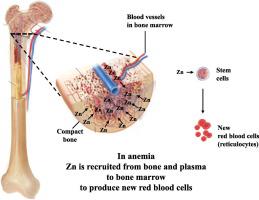Journal of Inorganic Biochemistry ( IF 3.8 ) Pub Date : 2020-07-04 , DOI: 10.1016/j.jinorgbio.2020.111172 Yen-Hua Chen,Sen-Shyong Jeng,Ya-Chia Hsu,Yu-Min Liao,Yu-Xin Wang,Xia Cao,Lian-Jiang Huang

|
Anemia is highly prevalent in people with chronic kidney disease (CKD), and CKD patients always have lower plasma but higher erythrocyte Zn levels than healthy people. To date, no satisfactory mechanism has explained these Zn metabolism abnormalities. We collected blood samples from patients on hemodialysis, 5/6 nephrectomized rats and phenylhydrazine (PHZ)-induced anemic mice and rats and compared them with their normal counterparts. We found that all the anemic animals had significantly decreased plasma Zn levels but elevated erythrocyte Zn levels. We also found that in anemic mice, new red blood cells (reticulocytes) had a ~7-fold higher Zn concentration than mature erythrocytes. When excess Zn was supplied to the rats, there was a ~1.2-fold increase in the Zn level in the rat bones. When Zn was depleted in the rats, the bones lost the greatest amount of Zn in the body (a 45% decrease). We prepared Zn-depleted rats and rendered these rats anemic by treating them with PHZ, and we compared them with normal rats. We found that in PHZ-induced anemia, rats released ~16% of Zn from their bones. Rat bones not only act as a ‘reservoir’ to adjust the excess or deficient Zn levels but also release Zn in anemia, and the released Zn stimulates erythropoiesis in the bone marrow. In anemia, Zn is redistributed from the plasma (causing the plasma Zn level to decreases) and bones to the bone marrow to produce reticulocytes (causing erythrocyte Zn level elevation).
中文翻译:

在贫血中,锌从骨骼和血浆中募集产生新的红细胞。
贫血在慢性肾脏病(CKD)患者中非常普遍,并且CKD患者的血浆总是比健康人低,但红细胞锌水平较高。迄今为止,尚无令人满意的机制解释这些锌代谢异常。我们收集了接受血液透析的患者,5/6肾切除的大鼠和苯肼(PHZ)诱导的贫血小鼠和大鼠的血液样本,并将它们与正常人进行了比较。我们发现所有贫血动物的血浆锌水平均显着下降,但红细胞锌水平却升高。我们还发现,在贫血小鼠中,新的红细胞(网状细胞)的锌浓度比成熟的红细胞高约7倍。当向大鼠提供过量的锌时,大鼠骨骼中的锌含量增加了约1.2倍。当锌在大鼠中耗尽时,骨骼中锌的损失量最大(减少了45%)。我们准备了缺锌大鼠,并用PHZ处理使它们贫血,并将其与正常大鼠进行了比较。我们发现,在PHZ引起的贫血中,大鼠从骨骼中释放了约16%的锌。大鼠骨骼不仅充当“储库”以调节过量或不足的锌水平,而且在贫血中也会释放锌,并且释放的锌会刺激骨髓中的红细胞生成。在贫血中,锌从血浆中重新分布(导致血浆锌水平降低),骨骼从骨骼重新分布到骨髓以产生网织红细胞(导致红细胞锌水平升高)。大鼠从骨骼中释放了约16%的锌。大鼠骨骼不仅充当“储库”以调节过量或不足的锌水平,而且在贫血中也会释放锌,并且释放的锌会刺激骨髓中的红细胞生成。在贫血中,锌从血浆中重新分布(导致血浆锌水平降低),骨骼从骨骼重新分布到骨髓以产生网织红细胞(导致红细胞锌水平升高)。大鼠从骨骼中释放了约16%的锌。大鼠骨骼不仅充当“储库”以调节过量或不足的锌水平,而且在贫血中也会释放锌,并且释放的锌会刺激骨髓中的红细胞生成。在贫血中,锌从血浆中重新分布(导致血浆锌水平降低),骨骼从骨骼重新分布到骨髓以产生网织红细胞(导致红细胞锌水平升高)。











































 京公网安备 11010802027423号
京公网安备 11010802027423号